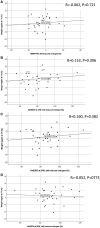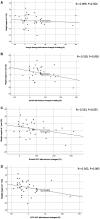Physiological Predictors of Weight Regain at 1-Year Follow-Up in Weight-Reduced Adults with Obesity
- PMID: 31004405
- PMCID: PMC6593985
- DOI: 10.1002/oby.22476
Physiological Predictors of Weight Regain at 1-Year Follow-Up in Weight-Reduced Adults with Obesity
Abstract
Objective: This study aimed to assess whether changes in resting metabolic rate (RMR), exercise-induced energy expenditure (EIEE), and appetite following weight loss (WL) are associated with weight regain at 1 year.
Methods: Thirty-six adults with obesity underwent 8 weeks of a very-low-energy diet, followed by 4 weeks of refeeding and a 1-year maintenance program. RMR, EIEE, appetite ratings, and active ghrelin, peptide YY, glucagon-like peptide-1, cholecystokinin, and insulin concentrations were measured at baseline, week 13, and 1 year.
Results: A 17% WL (-20 ± 5 kg [mean ± SD]; range: -11.7 to -32.2 kg; P < 0.001) was achieved at week 13. After 1 year, weight regain was 2.5 ± 9.0 kg (not significant), ranging from -18.2 to 22.5 kg. Both fat mass and fat-free mass were reduced at week 13 (-17.9 ± 4.8 and -2.9 ± 2.7 kg, respectively; P < 0.001), while only loss of fat mass was sustained at 1 year. WL was associated with reduced RMR, EIEE, and fasting/postprandial insulin (all P < 0.001), as well as increased fasting hunger (P < 0.01) and fasting/postprandial active ghrelin (P < 0.001). There were no significant correlations between changes in RMR, EIEE, or appetite with WL and weight regain at 1 year.
Conclusions: No clear evidence emerged that changes in RMR, EIEE, or appetite following WL can predict weight regain at 1 year, but larger studies are needed to confirm these results.
Trial registration: ClinicalTrials.gov NCT01834859.
© 2019 The Authors. Obesity published by Wiley Periodicals, Inc. on behalf of The Obesity Society (TOS).
Figures


References
-
- Purcell K, Sumithran P, Prendergast LA, Bouniu CJ, Delbridge E, Proietto J. The effect of rate of weight loss on long‐term weight management: a randomised controlled trial. Lancet Diabetes Endocrinol 2014;2:954‐962. - PubMed
-
- Anderson JW, Kons EC, Frederich RC, Wood CL. Long‐term weight‐loss maintenance: a meta‐analysis of US studies. Am J Clin Nutr 2001;74:579‐584. - PubMed
Publication types
MeSH terms
Associated data
LinkOut - more resources
Full Text Sources
Medical

